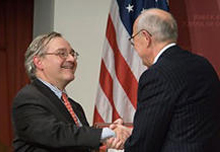
November 16, 2006 — New media, old media, and their synergy in fostering robust democracy were the topics taken up by syndicated columnist E.J. Dionne, Jr. at the J.F. Kennedy Jr. Forum on Thursday evening. Delivering the 2006 Theodore H. White Lecture, Dionne hearkened back to the days of 18th century “pamphleteering” as an earlier tradition of opinionated journalism, and suggested that objectivity in reporting is a more modern practice that is benefiting from the injection of passion and opinion delivered by the “new media.”
- Watch the Video
- Read the Transcript
“For all its shortcomings, the success of opinionated journalism on the radio and cable television and the blogs reflects a public thirst for debate and argument that goes beyond the confines usually imposed by conventional definitions of news,” Dionne said. “The lesson is not that all should copy their style of argument — God forbid — but that argument and engagement are very much in demand.”
Dionne advocated that the old media “welcome the raucous argument of the new media because it is one of the gifts of a democratic republic to have raucous arguments.”
In addition to Dionne’s talk, the evening was also devoted to awarding the second David Nyhan Prize for Political Journalism, which was awarded to political columnist Molly Ivins.
At a panel discussion Friday morning after the awards, Jack Shafer, editor-at-large for Slate magazine, responding to Dionne’s remarks by asserting that the distinction he made between new and old media is inaccurate.
“By my definition almost everybody in the media is a new media artist. I imagine that most of the columns E.J. writes begin with a Nexus search, a Google crawl, maybe a skimming of YouTube for a speech he missed, and minor surfing with his favorite blog. That is not all that much different than what the guy who writes in his pajamas might do.
“Instead of complaining about the new media and marginalizing them as parasites,” Shafer remarked, “journalists would be better off burying them with sheer excellence — better, smarter stories.”
The distinction is not between old and new media, responded Dionne, but between opinion journalism and old fashioned reporting.
“Opinion is easy and cheap compared to the old-fashioned reporting,” he said. “We should value the opinion stuff more than we in the old media tend to do, but we need to figure out ways of defending old-fashioned reporting.”
According to panelist Christina Martin, senior vice president of corporate communications for the Securities Industry Association, newspapers are now part of a master program of communicating information.
“They’re complements. I need both [new and old media] to do my job well,” said Martin, adding that what continues to be important is good writing. “We’re reaching a day and age where content is king.”
Panelist and political columnist Molly Ivins agreed that old and new media can complement one another. The real problem, said Ivins, is the destructive actions made by today’s newspaper owners, who are eroding the infrastructure for supplying news from different parts of the world. “We’re in deep trouble,” said Ivins, “but not because of the new media.”
The panel also included Garance Franke-Ruta, senior editor at the American Prospect, and Sidney Verba, Harvard professor and director of the Harvard University Library.
This article was written by Molly Lanzarotta and Sarah Abrams of the Harvard Kennedy School. The original article is here.

